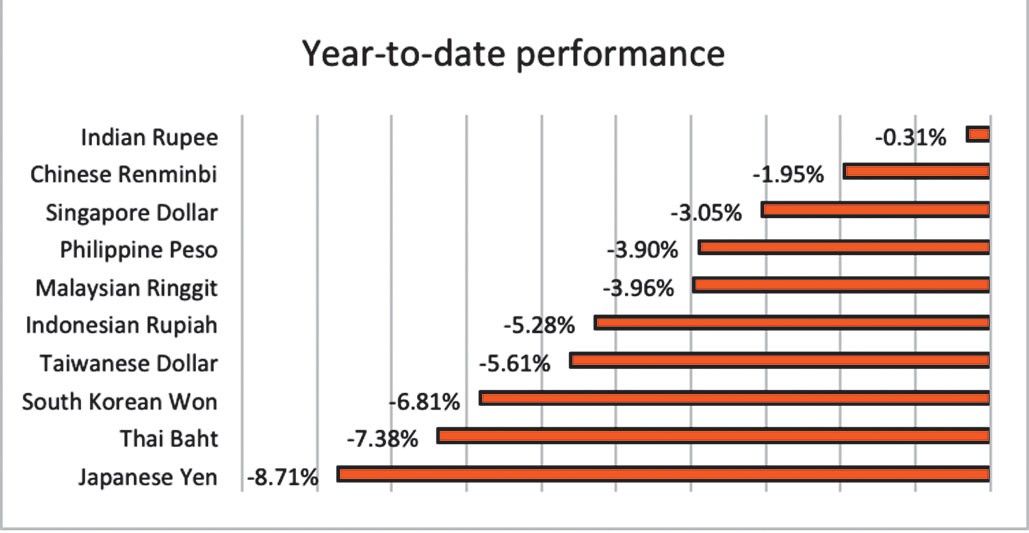War escalates, dollar surges

What investors have been fearing has finally materialized – a direct conflict between Israel and Iran. This came about after Israeli attacks on Gaza and proxy wars involving Hezbollah in Lebanon, the Houthis in Yemen, and other Iran-backed militia. Last Friday, Israel launched a drone attack on Iran. This was in retaliation to Iran’s April 14 attack on Israel involving more than 300 drones and missiles. The US dollar index (DXY) is now at 106.12, up 4.7 percent year-to-date.
Safe haven during wars and conflicts
On top of the ongoing Russia-Ukraine and Israel-Hamas wars, there are now fears that the escalating conflict between Israel and Iran would result in a bigger regional war. This has bolstered the demand for the US dollar as a safe haven. People flock to safety of the US dollar whenever there are conflicts in critical areas in the world.
Strong dollar pushes down Asian currencies to new lows
The strength of the US dollar has consequently resulted in the broad-based weakness of most global currencies, particularly Asian and emerging market currencies. Below, we list some of the recent moves of Asian currencies in light of the stronger US dollar.
Japanese yen. As Japan exits negative interest rates, the yen is now at 154, a 34-year low.
Chinese yuan. Chinese authorities adjusted the daily reference rate for the yuan. This may pave the way for weakness in Asian currencies and for the yuan to retest the psychological level of 7.30.
Indian rupee. The Indian rupee hit a record low of 83.72.
Malaysian ringgit. The ringgit fell to a near 26-year low.
Indonesian rupiah. The rupiah fell past 16,000 for the first time since 2020.
Taiwanese dollar. The Taiwanese dollar dropped to its lowest level in eight years.
Korean won. The won slumped to 1,400 per dollar, its lowest since 2022.
Philippine peso. Reflecting the weakening of Asian currencies, the peso also weakened. The peso broke 57 and touched an intraday low of 57.65, its lowest level since November 2022.
South China Sea incidents affect peso
Incidents in the South China Sea between China and the Philippines cause the peso to weaken. Bangko Sentral ng Pilipinas (BSP) Governor Eli Remolona said, “There’s a risk whenever there’s an incident in the Philippine Sea, the peso depreciates a bit.” The 57 level was a line in the sand that was staunchly defended by the BSP last year. However, this time around, because of the strength of the US dollar against all currencies, the central bank has hardly intervened in the forex market. Remolona added, “If the peso is weakening along with other currencies, then we don’t really try to intervene.”

Source: Bloomberg
Higher-for-longer interest rates
It is not only the war that is driving the dollar higher but also the prospect of higher-for-longer interest rates. Recent economic data (retail sales, nonfarm payrolls, unemployment, wages) show that the US economy remains strong and is firing on all cylinders. This came with three straight months of hotter-than-expected inflation. Federal Reserve (Fed) Chair Jerome Powell noted, “The recent data have clearly not given us greater confidence and instead indicate that it is likely to take longer than expected to achieve that confidence.” Powell added, “Given the strength of the labor market and progress on inflation so far, it is appropriate to allow restrictive policy further time to work and let the data and the evolving outlook guide us.” Federal Reserve Bank of Atlanta President Raphael Bostic said that he does not see the Fed easing until the end of 2024. Meanwhile, Federal Reserve Bank of Minneapolis President Neel Kashkari floated the possibility of no rate cuts in 2024 as the Fed could hold rates steady all year.
Divergent rate cuts
Because different countries have different economic growth rates and are at varying stages of the economic cycle, rate cuts around the world may not come at the same time. European Central Bank (ECB) President Christine Lagarde said, “We are heading towards a moment where we have to moderate the restrictive monetary policy.” Other countries may cut rates sooner, and the US may actually be one of the last countries to reduce rates. The Swiss National Bank (SNB) was the first major central bank to cut rates. The Swiss franc is down 7.4 percent year-to-date. The European economy is weaker than the US, and Europe may also cut ahead of the US. The euro is down 3.4 percent year-to-date. Despite the rise in crude oil prices, the Canadian dollar is down 3.8 percent year-to-date and the Norwegian krone is down 7.8 percent year-to-date.
War developments to determine dollar direction
So far, Iran has downplayed the latest attack. While the Iran-Israel conflict has been a tit-for-tat, the Israeli attacks have so far been measured and contained. The limited nature of the drone attack has caused the initial surge of oil, dollar, and gold to recede. Hopefully, the conflict does not result in a full-blown war. The US dollar as a safe haven currency will just shoot up higher in the event of an all-out war. The dollar is being boosted by higher-for-longer interest rates as the Fed would likely delay prospective rate cuts amid sticky inflation and a strong US economy. Ultimately, the direction of the dollar will depend on US interest rates and geopolitical developments in the Middle East, particularly the war between Iran and Israel.
Philequity Management is the fund manager of the leading mutual funds in the Philippines. Visit www. phlequity.net to learn more about Philequity’s managed funds or to view previous articles. For inquiries or to send feedback, please call (02) 8250-8700 or email ask@philequity.net.
- Latest
- Trending































